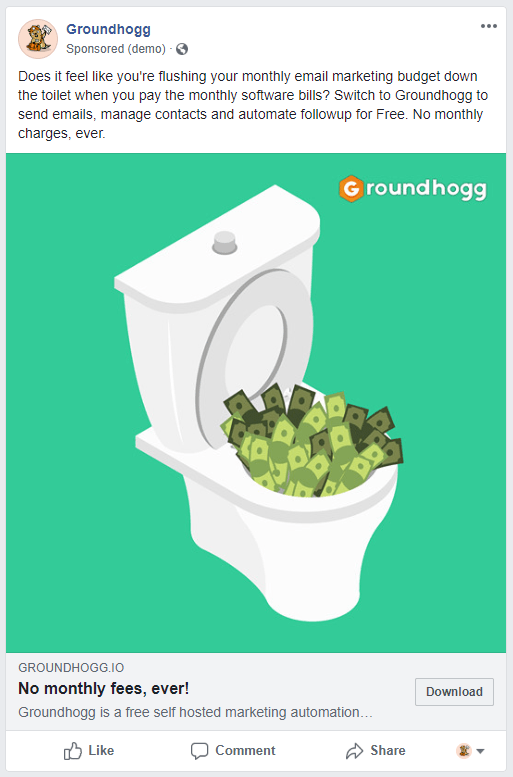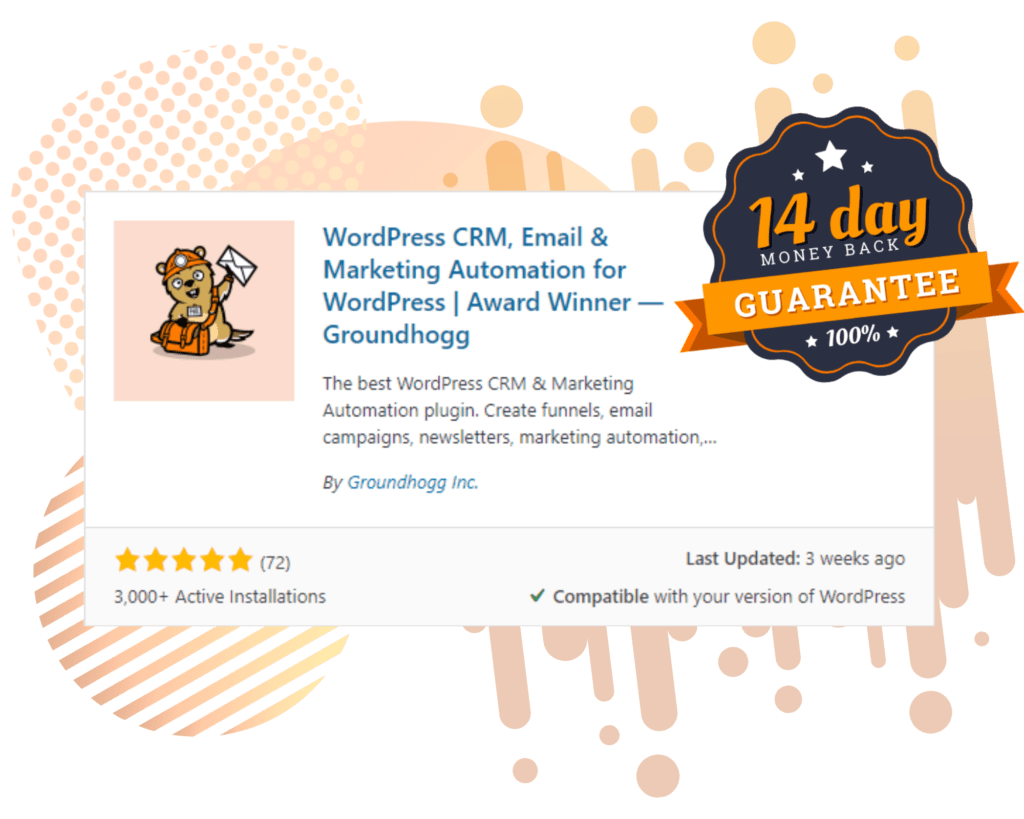Are you trying to build an audience without spending money on Pay Per Click advertising?
Prefer to watch instead of read?
You can learn everything in this article in recorded office hours session #45!
Most new founders are told that they should set aside a sizable budget to spend exclusively on Facebook and Google ads, but why?
If you ask me, this is because most people don’t know how to build an audience without spending money on PPC ads.
Over the last year, we have grown Groundhogg to 1,200+ active installs, an email list size of 2,000+ and 800+ members in our Facebook group without spending a dime on PPC, and I’m going to share with you how we did it.
But first…
How To Waste $3,000 In 30 Days.

I remember when we first launched Groundhogg, right after getting into the WordPress repository, we set aside money to run Facebook ads and Google ads, and ran them for 1 month.
At the end of the month we had spent $3,000 and had made $0 in return. That is what you call an epic fail.
There were several reasons why our strategy didn’t work…
- I didn’t know what I was doing, so my ads sucked.
- We had little social proof at the time to back up the ads.
- We spent a lot of money in locations that did not have the money to buy our products.
These fatal errors led to a big $3,000 bill that we will never get back.
After cancelling our ads, I had to figure out a different way to reach our audience, and that started with a few questions.
Who Is Our Ideal Customer?
You’ve likely heard this question before and you might actually have an answer, but I find that a lot of businesses miss some of the details when designing their perfect customer.
I learned this from Dan Martel, when designing your perfect customer, you have to get super specific, even if your model excludes any current customers you might have.
Answer these types of questions about your perfect customer.

- How old are they?
- Are they Male/Female/Other?
- Where do they live?
- Do they have children?
- Are they married?
- Where do they work?
- Where do they drink, do they drink?
- Are they employees, or are they managers?
- Do they or their kids play sports?
- How busy are they?
- Do they own a business?
- Do they spend time on social media?
- What shows do they watch?
Once I started answering these specific questions about my perfect customer I learned a few things that would help me identify them and connect better with them.
At the time of re-finding my perfect customer, I just knew that I wanted to work with small businesses and entrepreneurs, but I had my whole world view changed.
I started to notice that my perfect customer wasn’t necessarily business owners and entrepreneurs, but in fact our perfect customer was digital marketing agencies and freelancers.
Why? Because most small business owners are busy building their business and taking care of their customers, they don’t have time for building a sales funnel. So, they outsource the marketing to an agency, who then chooses their preferred CRM platform to use for the customer.
We had to change a lot of our marketing to attract agencies and offer products conducive to the agency experience and almost immediately sales took off.
Let’s do an example. Let’s say we’re a marketing agency and our ideal customer is a small business, 2-5 employees, in the women’s retail fashion space.
Women’s fashion retail is something I know very little about, but even based on my limited knowledge we can answer some of the basic questions we need to put a strategy together.
Remember, we want to be very specific, this does not necessarily mean we cannot cater to customers who don’t match this description.

- Male/Female/Other: Female
- Where do they live: Cities, 100,000-500,000 people
- Do they have children: Yes
- Are they married: No
- Where do they work: Their retail location
- Are they employees, or are they managers: Managers
- Do they or their kids play sports: Soccer
- How busy are they: VERY
- Do they own a business: Yes
- Do they spend time on social media: Yes, instagram
- What shows do they watch: The Devil Wears Prada
We’ll call the description of this person, “Janet.” You should go through this process a few times and choose the profile of the person you’d most like to work with.
The Halo Effect
Although our ideal customer is a marketing agency, 66% of our customers are still solopreneurs and business owners, not agencies. Why is that?

The reason you should not be afraid of getting super specific about your customer is because your ideal customers will bring other types of customers with them. This is called the Halo Effect. This is also something I learned from Dan Martel.
Your ideal customers share similar attributes with other types of customers, and those similar attributes will attract a broader range of buyers once they see your ideal customer get positive results with your product.
Now that we know more about our ideal customer, we can start to figure out how to get them into our community by asking the question…
Where Does Our Ideal Customer Hang Out?
This is arguably the most important question you could ask about your ideal customer, because the answer to this question is the same answer to the question, “Where can I find more customers?”
Take the marketing agency example. Do agency owners spend a lot of time scrolling through their Facebook feed? As a former agency person, I know the answer is no. If they are spending time on Facebook, it’s in groups or in messenger. That explains why I wasted $3,000.
It’s important to know where they hang out, it’s also helpful to know how they spend their free time as well.
So, where do agencies in the WordPress space hang out and spend their time and why are they there?
- Facebook groups: for support help and advice
- WordCamps: to learn new trends and network
- Podcasts: to learn new strategies
- Masterminds: to learn new strategies and share their knowledge
- Conferences: to network and find customers
Pulling from our example of Janet and her retail fashion business, let’s figure out where she spends most of her time?
- On instagram sharing photos of her clothing lineup.
- At conferences showcasing and selling new items.
- At the soccer field, with her two sons.
- In the facebook group called “Fancy Fashion Shops California.”
- At small runway fashion events.
So, the question becomes what to do with this information?
Are You Where The Ideal Customer Is?
Have you ever heard the phrase, “It’s easier to go to your customer than to have your custom come to you.” I don’t know who said it but it’s incredibly appropriate.

There is no business that adopts this line of thinking better than the food truck.
The food truck goes wherever the people are, the fair, conventions, schools, always there feeding the hungry en-mass.
When building your audience for the first time, you have to act like a food truck. You have to go to where your customers are spending their time and be there to fulfil their needs when they need help.
When building the Groundhogg audience, I reflected on how and where I spent my time when I was in the agency business.
I spent a lot of time in WordPress focused Facebook groups, listened to marketing and WordPress focused podcasts, I went to WordCamps and local business meetups and conferences.
Thus, we needed Groundhogg to have a presence in those areas. Get a booth and sponsor conferences, be a guest speaker on podcasts and join all those Facebook groups.
So now that you have a presence in the areas your ideal customer is, the question becomes, “How do you turn presence into customers?”
Would You Rather Be Helped Or Sold To?
Now that we are in front of our ideal customer, what do we do? What do we say?
There are two approaches, I believe one to be much more rewarding than the other.
Most people: Always be closing!
Have you ever seen the movie Glengarry Glen Ross? One of the most famous sales tactics is taken directly from the script.
Always Be Closing!
I see a lot of entrepreneurs and sales people try and ram information, sales, deals, and how great they are down people’s throats. But that doesn’t actually help them in any way.
Think of all the YouTube ads of the dropshipping guy with the probably rented lamborghini in the background. Whenever I see those all I can do is groan. Why? The ad is all about him and his success, not your problems or how they can be solved, which is what customers want!
Even if someone does buy based on your persistent selling, the chances that they will remain a customer long term are low because of the poor sales experience.
I prefer to use this much more customer friendly, and as a result revenue friendly, method to attract new customers.
Always be helping!
It’s amazing what happens when you help someone solve their problem.
Whenever I look for new clients I ask not what I can sell them, but rather what problems can I help them solve?

If you come from a place of service, people are much more receptive to your offer and your advice, as long as you remain humble, no one likes a know-it-all.
When I was in the early days of growing Groundhogg, I would join other peoples Facebook groups and just answer questions people had about marketing and CRM. When answering the questions I would use Groundhogg as an example or as part of the solution to their problem.
When I answered their questions, usually their first response was, “Thanks so much! What’s Groundhogg?” Which is basically an open invitation to start a sales conversation.
There is something called, “the law of reciprocity.” If you help enough people get what they want, you can get what you want.
After doing this for a few weeks I ended up having conversations with prominent members of the WordPress community…
- Jonathan Denwood (WP-Tonic)
- Spencer Foreman (LaunchFlows)
- Chris Badget (LifterLMS)
- Jack Arturo (WPFusion)
I was then able to join webinars, podcasts and more with them and help their audience, further growing my own at the same time.
I went from 1-on-1 helping to 1-on-many helping, establishing relationships and building bridges with people who were just as interested in helping me with my own goals.
That’s the crazy thing about helping people. When others see you helping, all they want to do is help you help others.
Customers and revenue will start to trickle in as a result of your generosity, and from there you can continue to build your audience.
Almost a year ago, I remember doing my first panel on the WP-Tonic show, and Chris from LifterLMS was on the call. After the call Chris reached out to me and asked if I would come on his weekly mastermind meeting with his group.
Turns out, a lot of his customers have CRM and email issues, and I happen to know a lot about email and CRM.
So I got on the call with him and I was able to talk about Groundhogg, help some of his customers with their marketing and email and got a few customers out of it!
Over a year later, Chris and I are good friends and do a lot of cross promotion, continuing to help each other’s audiences. We also have a bunch of LifterLMS clients as our own clients!
That’s the power of helping.
How Do We Turn Helping Into Sales?
While it’s all well and good helping people for free and being generous with your knowledge and time, you have to eat and feed your family. So how do you turn generosity into income?
The universe and the law of reciprocity takes care of a lot of this for you, but you can help it out a little by doing a few of these things.
- Don’t give away everything you know. You can be helpful, but it doesn’t mean you have to give away your bread and butter. Just give enough to solve the immediate problem.
- Use your product as part of the solution. This is great if you have a software product like Groundhogg, because the product itself might be the solution, or you can use a feature of it as part of the solution to the problem.
- Let them know if they need more help where they can get it and direct them to a YouTube video or course. This works great if the answer to their question is complex, and frequent! The course or video can advertise your product or service.
- Be accessible, be open to replies and feedback. You can help more by being an active member of the conversation.
- Actively seek out opportunities to help people, you don’t always have to wait for a question to come in. Many times the question is there, but the customer doesn’t have the words to form it.
One of the first things I did when I started my help people first approach was to reach out to every WordPress Agency focused podcast that would take me and offering to bring value by training some digital marketing concepts during the show.
I did maybe 5 or 6 podcasts with several different hosts based on the show topic, “How to use digital marketing effectively in 2019.”
That sounds a lot more helpful than, “How great Groundhogg is and how I made $1,000,000 in 4 days.”
Most of the shows I did let me include a discount offer for Groundhogg at the end because I was helpful and my content was good. This is certainly something you can do as well.
Why Don’t More People Do This?
Well, because it’s hard, and it takes a lot of time.
It’s much easier to spend $3,000 on Facebook ads than it is to spend 2 years helping people and being an active member of several communities.
However, the results of the effort put in by our team into helping our audience have far exceeded the results of any amount of money spent on advertising.
If you’re serious about your business and serious about your customer’s success, be serious about helping people, free or paid, and the universe and your customers will reward you.
How Do You Start?
It can seem like a monumental task, and a lot of work. In some ways it is, and some ways it isn’t.
My approach to starting your helping first approach would be this.
- Block off 1 hour of your day for exclusively helping people. If you have more to give, give more!
- Join 5 groups, masterminds, clubs, whatever you need to get in front of your ideal customer. 5 is a good number because it gives you enough diversity, but it’s not overwhelming to keep track of.
- After a few weeks of helping people and deeply understanding their issues, create a podcast topic that solves the most frequent issue you’ve seen and reach out to industry experts that have podcasts and their own audiences.
This is not an end-to-end plan, but it’s pretty much how we started, and here we are 2 years later!
Do you have any advice or tips that will help entrepreneurs build their audience without spending money on PCC? Post them in the comment below!


